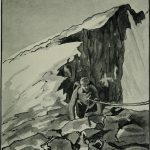Eat Climb Send: A Scientific Perspective
“Eating Your Way to Better Climbing,” written by sports science researcher Robert Portman, Ph.D., was published in Rock & Ice Issue 198 (December 2011) and is still applicable today.
As a biker and runner, Dr. Portman was utterly shocked when he got his butt handed to him while attempting to rock climb for the first time. He was even more shocked when he found out there was barely any research regarding the impact of nutrition on climbing performance.
He contacted fellow sports science researcher Dr. Seifert at Montana State University and proposed some studies. They selected seven males and one female, threw them on a treadwall (not literally), and documented the first study on nutrition for climbers. The results were presented at the 2011 annual meeting of the American College of Sports Medicine.
They found that rock climbing results in muscle fatigue and nutrient depletion more rapidly than any aerobic exercise. Because of this, there are certain consequences, such as acid levels increasing three-fold and remaining elevated even after the climb, (aka,”pumped), and extreme muscle fatigue. Acid buildup + muscle fatigue means climbers’ hand-grip strength can decrease as much as 57% from the beginning of a climb to the end.
The good news? There are ways to delay fatigue and offset rapid nutrient depletion. According to Dr. Portman’s findings, it’s all about a combination of carbohydrate and protein in a 4:1 ratio. Examples of a 4:1 snack: ¼ cup nut butter and ¾ cup of apple slices and bananas, or a high protein shake with a plant-based protein supplement (shake with unsweetened milk, blend with ice, avocado, and 1 cup leafy greens).
Dr. Portman highlights the three segments of every climb in which the 4:1 ratio is important: priming, fueling, and recovery. While priming (the time you’re prepping before the climb), climbers should consume 100-120 calories.
Fueling (referring to the time during your climb) should also be comprised of protein and carbohydrates; this can reduce muscle damage by 56%. Aim for 100-200 calories per hour based on the intensity of your climb.
Recovery (after you’re done climbing) is the most important segment according to the study. This window is open for only 45 minutes. Why? Two words: protein synthesis. The 45 minutes after you stop is crucial for repairing muscle tissue.
For all the details, tables, and stuff I missed, check out the full article here. He’s a big advocate for recovery drinks, but Rock and Ice points out that a turkey sandwich also works.
http://www.rockandice.com/rock-climbing-training/nutrition-eating-your-way-to-better-climbing?page=1







